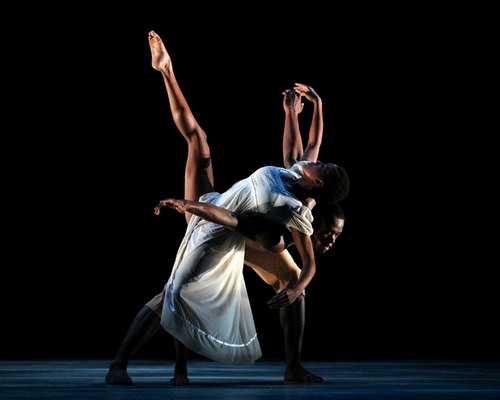|
 |
|
|
 |
 |
The performance of Uri Sands' Existence Without Form, a new piece commissioned for the 2006/2007 Alvin Ailey American Dance Theater (AAADT) season, was stunning. It's no wonder he was named one of "25 Choreographers to Watch" in 2005 by Dance Magazine. Sands, an AAADT alum, showed his ability to visually and emotionally move the audience through a single emotionally gripping plot. Existence Without Form consisted of four sections. As the curtain rose to the first section the stage was filled with low multicolored lighting and sparkles. The colored gels must have been covered with black gels full of holes. It seemed a little like a disco ball effect and had a mystical wonderland-type feel. The dancers seemed chaotic, each one dancing different steps. In the midst of the chaos there was one lone dancer, Wendy White Sasser, who didn't seem to be moving and had her back to the audience. However, Sasser carefully and undetectably moved diagonally from front stage right to upper stage left. The closer she got to her destination the more limp she became on her right side until she was bent in half, both hands touching the floor. All of this while dancers left the stage one by one, except Clifton Brown, who rolled back to Sasser in an unorganized fashion. He connected with Sasser who up to this point has been practically nonexistent among the dancers. The pas de deux that followed this connection was jaw dropping. Imagine for a moment those skeleton toy figures with a string at the top. As you lift the string quickly or slowly or yank it sideways, it responds and looks as if it were dancing. As soon as you stop moving the string, the figure quickly returns to its lifeless state. This is how Clifton Brown and Wendy White Sasser executed the second section. The partnering and technique necessary to perform such a visual picture was extraordinary. Sasser was limp, only coming to life with each move, sweep, turn and arabesque manipulated through Brown's each move. It was breathtaking. How did they do that? In section three, two women entered the stage dancing in sync, which up to this point didn't seem to fit the theme of the first two sections. However, it became evident that the two women are playing with and copying each another. The finale of this section perfectly validates the story as one of the dancers leaves the stage. Upon realizing that she is alone, the dancer left on stage searches for her friend and is lost without her. The fourth section seemed to have too much form. The dancing was beautiful and luscious, ending with a grand finale of sorts and flashing back to the opening lighting. However, it lacked a sense of identity in conjunction with the previous three sections, but maybe that is what the choreographer was seeking. Even so, I can't seem to stop thinking about this piece. Each of the three sections left a visual picture and stood out among the other new repertoire of the season. I agree with Dance Magazine, Uri Sands is one choreographer I look forward to watching.
 Asha Thomas and Jamar Roberts in Existence Without Form by Uri Sands Photo © & courtesy of Paul Kolnik |
|
|
|


